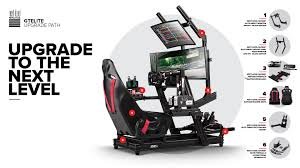
racing simulator cockpit
What Is a Racing Simulator Cockpit?
A racing simulator cockpit is a specially designed frame or seat that replicates the driving position of a real race car. It supports sim racing peripherals like a steering wheel, pedals, gear shifter, and even motion platforms, allowing gamers to experience ultra-realistic driving at home.
These cockpits are more than just gaming chairs—they are engineered to deliver the feel of real motorsports, making them a must-have for any serious sim racer.
Why You Need a Sim Racing Cockpit
If you’re using a desk or generic gaming chair for racing games, you’re only experiencing half the thrill. A dedicated racing simulator cockpit gives you:
- ✅ Ergonomic support for long sessions
- ✅ Fixed mounting points for realistic force feedback
- ✅ Adjustability to mimic different racing disciplines (F1, GT, Rally)
- ✅ Improved control accuracy and immersion
- ✅ Long-term durability compared to makeshift setups
Whether you’re racing in iRacing, Assetto Corsa, or Gran Turismo, the right cockpit transforms your experience from casual to competitive.
Key Components of a Racing Simulator Cockpit
A full sim racing setup involves several integrated parts. Here’s what a cockpit typically includes:
Racing Seat
- Mimics bucket seats found in real race cars
- Offers lumbar support and side bolsters
- Often comes with sliders or tilt adjusters
Wheel Mount
- Solid platform to attach a racing wheel base
- Designed to handle high torque from force feedback wheels
- Adjustable for height and angle
Pedal Plate
- Heavy-duty metal or carbon fiber base for mounting pedals
- Some allow angle adjustment or fore-aft movement
- Prevents pedal flex during heavy braking
Monitor Mount (Optional)
- Attaches single or triple screens to the frame
- Keeps screen at eye-level to simulate cockpit visibility
Gear Shifter / Handbrake Mount
- Holds shifters or handbrakes securely
- Usually adjustable for both left and right-hand use
For advanced racers, many cockpits also support motion platforms, wind simulators, and VR headsets.
Types of Sim Racing Cockpits
Not all racing cockpits are created equal. The type you choose depends on your space, budget, and goals:
Entry-Level Cockpits
- Foldable or compact designs
- Lightweight frames
- Best for casual players
- Affordable pricing
Mid-Range Cockpits
- Sturdier construction (steel or aluminum)
- Better ergonomics
- Compatible with load cell pedals and DD wheels
High-End / Professional Cockpits
- Constructed from 8020 aluminum extrusion
- Fully modular and highly customizable
- Support for direct drive wheels and motion rigs
- Used by professional sim racers and esports drivers
If you’re looking for a professional-grade experience, platforms like the Next Level Racing F-GT Elite offer premium features and precision engineering.
Racing Cockpit Compatibility
Your cockpit must be compatible with your racing hardware. Most quality cockpits support:
- Fanatec
- Logitech G29 / G923
- Thrustmaster
- Simucube
- Moza Racing
Before purchasing, always check mounting hole patterns and compatibility specs.
Space and Setup Considerations
Make sure to consider:
- Room size – Triple monitor setups require extra width
- Floor surface – Use anti-slip mats or rubber feet
- Cable management – Avoid trip hazards and tangles
- Assembly – Some rigs take 1–3 hours to build
If space is tight, look for foldable or modular rigs that can be stored vertically.
Racing Cockpit for VR vs Monitors
Many sim racers debate between VR and monitors. Here’s how cockpit setup changes based on the display:
| Display Type | Considerations |
|---|---|
| Triple Monitors | Need a monitor stand and enough space |
| Single Ultrawide | Great immersion, fewer cables |
| VR Headset | No need for screen mounts, but requires GPU power |
Cockpits like the GT Omega ART Cockpit are compatible with all display types, offering excellent flexibility.
Accessories to Enhance Your Experience
Take your sim racing cockpit to the next level with these upgrades:
- Motion platforms – Simulate road bumps, turns, and G-forces
- Buttkickers – Add vibrations for engine and road feel
- Wind simulators – Recreate airflow for added realism
- Button boxes – Easy access to car functions
- LED dash displays – Show speed, gear, and RPM in real-time
Each of these adds immersion and realism—especially when competing online.
Price Range of Sim Racing Cockpits
Pricing varies widely depending on quality and features:
| Tier | Price Range | Best For |
|---|---|---|
| Entry-Level | $150–$300 | Beginners or casual gamers |
| Mid-Range | $400–$800 | Intermediate sim racers |
| High-End | $1000+ | Pros and serious enthusiasts |
Don’t forget to factor in the cost of your wheel, pedals, seat, and accessories.
Best Brands for Racing Simulator Cockpits
Here are the most trusted names in the industry:
- GT Omega
- Next Level Racing
- Playseat
- SimLab
- Trak Racer
- OpenWheeler
Many of these brands are used by professional e-racers and even Formula 1 drivers for off-track training.
Benefits of Using a Racing Simulator Cockpit
- ✅ Realistic driving position mimics real motorsport
- ✅ Sturdy platform for powerful feedback wheels
- ✅ Improved immersion and game control
- ✅ Reduced physical fatigue from proper support
- ✅ Great for training, fun, or online competition
A solid cockpit is a long-term investment for anyone serious about sim racing.
Final Thoughts
A racing simulator cockpit transforms your gaming setup into a high-performance driving environment. From casual racers to esports champions, it’s the foundation for a more immersive, competitive, and comfortable racing experience.
Whether you’re aiming to shave seconds off your lap time or just want to feel like a real driver at home, investing in a quality sim racing cockpit puts you in the driver’s seat—literally.






